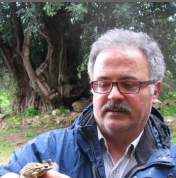Who are we?
This project rises from the joint collaboration between there young Biology Graduates, actives enough to create their own company (BioScripts), and their Zoology teacher (Faculty of Biology, University of Seville) with the disinterested support of the institutions listed in acknowledgements.
BioScripts

Francisco Gálvez Prada
franciscogp@bioscriptsdb.com Biology Degree, and Biochemistry student. He designed and implemented the database, the bone measurements and all the web resources related with the 360 view and representation of the measures in the pictures taken. Design of the CD/DVD multimedia.

Juan Pedro Serrano León
juanpedrosl@bioscriptsdb.com Biology student. He was responsible of generate the pictures of all the bones of the skeletons, including devising the picture procedure, maximizing time and efforts. He also photographed the Iberian lynxes kept in the Zoobotánico de Jerez.

Bernardino Sañudo Franquelo
bernardinosf@bioscriptsdb.com Biology student. Provided support in imaging processing..
Universidad de Sevilla

Juan Francisco Beltrán Gala
beltran@us.es. is Professor of the University of Seville (Department of Zoology). He was in charge of the direction, writing, and general coordination of the project. A graduatein Biological Sciences in the University of Seviile in 1981, he completed his Ph.D. on the ecology and behavioural ecology of the Iberian lynx in Doñana National Park (Beltrán, 1988). He has authored more than 60 publications, some of them in journals of highest impact (ej. Nature, on the Molecular Taxonomy of the Iberian lynx), as well as in other for general audiences as a way to spread throughout the society the results of his research (Investigación y Ciencia, Quercus, Trofeo, Natura, Panda, etc). This activity is complemented with conferences (ej. " A future with the Lynx ", cycle of conferences for Primary and Secondary schools of the villages of Doñana's surroundings ), articles in national newspapers, etc. More recently, he co-organized the First International Congress on University Teaching Innovation in Natural History (INNATUR 2012). To download a selection of these publications, please go to: click here
Acknowledgements
A work like this Atlas would not have been possible without the decisive collaboration of the following persons and institutions. We are grateful to all of them for the help for the completion of this project.
- We thank the University Seville (Faculty of Biology, Department of Zoology) in whose facilities we developed the photographic procedure, took measurements of the bones, designed and implemented most of the databases and wrote the texts.
- We thank Doñana's Biological research station (CSIC, Seville) for granting us the access to the magnificent collections of vertebrates, and for the temporary loan of the selected specimens for this Atlas.
- We thank Dr. Carlos Ibáñez Ulargui for his continuous support during the different phases of the project and for facilitating us the access to the Colección of Mammals of the EBD.
- We thank Teresa García Díez , for her help during the localization, selection and loan of specimens.
- We also thank the responsibles of the zoo-botanical garden “ Zoobotánico de Jerez de la Frontera”, who kindly granted to us access to a privileged place to obtain the wonderful pictures of Iberian lynxes (male and female) that illustrate these pages.
- Finally we also thank the Secretariado de Recursos Audiovisuales y Nuevas Tecnologías de la Universidad de Sevilla (SAV) for its help and collaboration to get this CD completed on time.